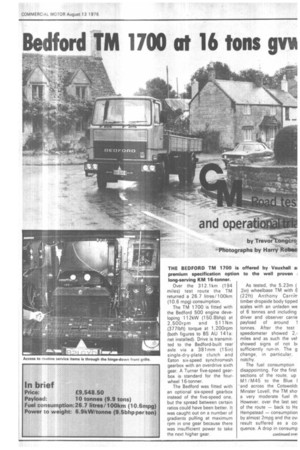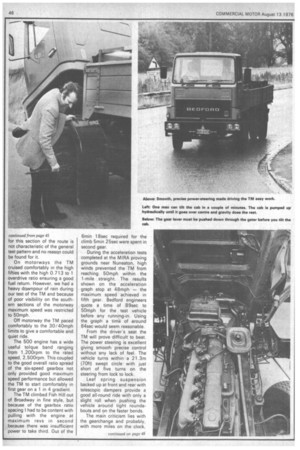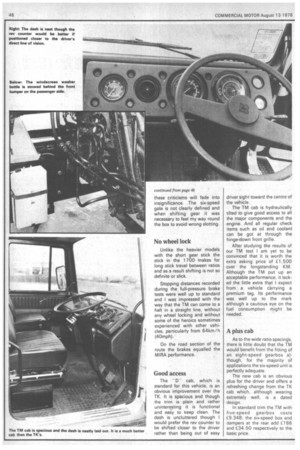M 1700 at 16 tons gni
Page 47

Page 48

Page 50

If you've noticed an error in this article please click here to report it so we can fix it.
4 '— by TrevorS: ongcrcy Photographs by Harry Hobson
THE BEDFORD TM 1700 is premium specification option long-serving KM 16-tonner.
Over the 312.1krn (194 miles) test route the TM returned a 26.7 litres/100km (10.6 mpg) consumption.
The TM 1700 is fitted with the Bedford 500 engine developing 112kW (150.8bhp) at 2,500rpm and 511Nm (377Ibft) torque at 1,200rpm (both figures to BS AU 141a: net installed). Drive is transmitted to the Bedford-built rear' axle via a 381mm (15in) single-dry-plate clutch and Eaton six-speed synchromesh gearbox with an overdrive sixth gear. A Turner five-speed gearbox is standard for the fourwheel 16-tonner.
The Bedford was fitted with an optional six-speed gearbox instead of the five-speed one, but the spread between certain ratios could have been better. It was caught out on a number of gradients pulling at maximum rpm in one gear because there was insufficient power to take the next higher gear. offered by Vauxhall a: to the well proven
As tested, the 5.23m ( 2in) wheelbase TM with 6 (22ft) Anthony Carri-rr timber dropside body tipped scales with an unladen we of 6 tonnes and including driver and observer carrie payload of around 1 tonnes. After the test speedometer showed 2,, miles and as such the velshowed signs of not bi sufficiently run-in. The g change, in particular, notchy.
The fuel consumption disappointing For the first sections of the route, up M1 /11/145 to the Blue I and across the Cotswolth Minster Lovell, the TM sho' a very moderate fuel th However, over the last sec of the route — back to He. Hempstead — consumption by almost 2mpg and the ovI result suffered as a col quence. A drop in consump for this section of the route is not characteristic of the general test pattern and no reason could be found for it.
On motorways the TM cruised comfortably in the high fifties with the high 0.713 to 1 ,overdrive ratio ensuring a good fuel return. However, we had a heavy do.wnpour of rain during our test of the TM and because of poor visibility on the southern sections of the motorway maximum speed was restricted to 50mph.
Off motorway the TM paced comfortably to the 30/40mph limits to give a comfortable and quiet ride.
The 500 engine has a wide useful toi-que band ranging from 1,200rpm to the rated speed, 2,500rpm. This coupled to the good overall ratio spread of the six-speed gearbox not only provided good maximum speed performance but allowed the TM to start comfortably in first gear on a 1 in 4 gradient.
The TM climbed Fish Hill out of Broadway in fine style, but because of the gearbox ratio spacing I had to be content with pulling with the engine at maximum revs in second because there was insufficient power to take third. Out of the 6min 18sec required for the climb 5min 25sec were spent in second gear.
During the acceleration tests completed at the MIRA proving grounds near Nuneaton, high winds prevented the TM from reaching 50mph within the 1-mile straight. The results shown on the acceleration graph stop at 48mph — the maximum speed achieved in fifth gear. Bedford engineers quote a time of 89sec to 50mph for the test vehicle before any running-in. Using the graph a time of around 84sec would seem reasonable.
From the driver's seat the TM will prove difficult to beat. The power steering is excellent giving smooth precise control without any lack of feel. The vehicle turns within a 21.3m (70ft) swept circle with just short of five turns on the steering from lock to lock.
Leaf spring suspension backed up at front and rear with telescopic dampers provide a good all-round ride with only a slight roll when pushing the vehicle around tight roundabouts and on the faster bends.
The main criticism lies with the gearchange and probably, with more miles on the clock, these criticisms will fade into insignificance. The six-speed gate is not clearly defined and when shifting gear it was necessary to feel my way round the box to avoid wrong slotting.
No wheel lock
Unlike the heavier models with the short gear stick the stick in the 1700 makes for long stick travel between ratios and as a result shifting is not so definite or slick.
Stopping distances recorded during the full-pressure brake tests were well up to standard and I was impressed with the way that the TM can come to a halt in a straight line, without any wheel locking and without some of the heroics sometimes experienced with other vehicles, particularly from 64km /h (40mph).
On the road section of the route the brakes equalled the MIRA performance.
Good access
The " D'' cab, which is standard for this vehicle, is an obvious improvement over the TK. It is spacious and though the trim is plain and rather uninteresting it is functional_ and easy to keep clean. The dash is uncluttered though I would prefer the rev counter to be shifted closer to the driver rather than being out of easy driver sight toward the centre of the vehicle.
The TM cab is hydraulically tilted to give good access to all the major components and the engine. And all regular check items such as oil and coolant can be got at through the hinge-down front grille.
After studying the results of our TM test I am yet to be convinced that it is worth the extra asking price of £1,500 over the longstanding KM. Although the TM put up an acceptable performance, it lacked the little extra that I expect from a vehicle carrying a premium tag. Its performance was well up to the mark although a cautious eye on the fuel consumption might be needed.
A plus cab
As to the wide ratio spacings, there is little doubt that the TM would benefit from the fitting of an eight-speed gearbox although, for the majority of applications the six-speed unit is perfectly adequate.
The new cab is an obvious plus for the driver and offers a refreshing change from the TK cab which, although wearing extremely well, is a dated design.
In standard trim the TM with five-speed gearbox costs £9,348; the six-speed box and dampers at the rear add £166 and £34.50 respectively to the basic price.




























































































